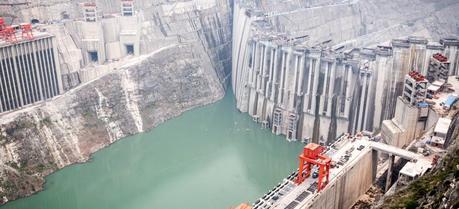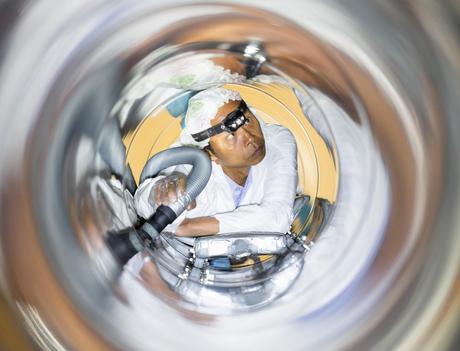 Looking upstream on the Jinsha Jiang River at the Xiloudu Dam, you can see two of the water entry openings. The dam filling with water is ongoing. (Сredit: Siemens AG, Munich/Berlin)
Looking upstream on the Jinsha Jiang River at the Xiloudu Dam, you can see two of the water entry openings. The dam filling with water is ongoing. (Сredit: Siemens AG, Munich/Berlin)
Siemens, a German multinational engineering and electronics company, has completed the construction of a high-voltage gas-insulated transmission line (GIL) for China Three Gorges Project Corporation at the country’s second largest hydropower plant Xiluodu.
The Xiluodu Dam is an arch dam in the southwest of China on the Jinsha Jiang River. Construction on the dam began in 2003. The first of 18 770 MW Francis turbine-generators was commissioned on 15 July 2013. The remainder are expected to be commissioned by 2014. The 285.5 m (937 ft.) tall dam is one of the tallest in the world. The total generating capacity will be 13,860 MW.The project consisted of the installation of a total of seven three-pole systems, each with a length of 620 m (2034 ft.). The single-pole tube length is 12.5 kilometers (7.76 mi.), making this the world’s longest gas-insulated transmission line. Earlier we reported that Xiluodu is also home of the world’s largest 784 megawatt (MW) generator-turbine unit built by Voith.
This system features a second world record—designed for a power capacity of 3900 megavolt ampere (MVA) at a voltage of 550 Kilovolt (kV) and a rated current of 4500 ampere (A), this is the world’s highest-capacity connection using gas-insulated transmission line.

An unique perspective — a view of the inside of the GIL tubes during the extensive cleaning process, which takes place inside a prefabrication tent to eliminate dust. (Сredit: Siemens AG, Munich/Berlin). Click to enlarge.
In order to transport electricity from the dam to the population centers in the eastern part of the country, power must first travel from the turbines in the power plant cavern to the overhead transmission lines, a distance of about 460 meters (1509 ft.). Seven three-pole gas-insulated transmission line systems, which are inserted vertically in four shafts to the right and left of the dam, each transmit 3900 MVA of power safely and efficiently to the overhead power lines.
Using a gas-insulated transmission line instead of a high-voltage cable has the added advantage of its special design that eliminates any risk of fire. GIL tubes are not flammable. In the event of a malfunction, they do not represent a fire load and thus pose no hazard to operating personnel. The tunnel of the insulated high-voltage lines can also be used as ventilation and service shafts for personnel. Optimal values for electromagnetic compatibility, increased earthquake resistance, a leak-proof design due to welding style, and the fact that GIL’s do not age, round out the system’s broad benefits. Additionally, the GIL tubes are welded over their entire length. This not only increases operational reliability but also gives the GIL tube flexibility, so it can adapt to any changes in the tunnel wall that occur over time.
The welding of the GIL’s aluminum tubes is an innovative high-tech process that requires clean-room conditions. The latest welding and ultrasound methods ensured the required quality was achieved, and allowed rapid installation of the gas-insulated lines.
The individual GIL modules, each of which is about 11.5 meters (37.7 ft.) long, were welded directly to each other in a vertical position inside the installation shafts, and then pushed upward, section by section, in the tunnel. Various branch-offs and horizontal sections extend the overall length of the individual three-phase systems to 620 meters (2034 ft.).
“In the Xiluodu project, we completed the world’s longest vertical GIL installation,” says project manager Mathias Schreiber, Siemens Energy. “This is also the first time technical figures such as 550 kilovolts of operating voltage and 3900 MVA transmission power per system have been involved. We’re proud that we completed this massive project in such a short time under complex installation conditions at the job site.”
After the first of the seven GIL systems passed high-voltage testing in March 2013, three more systems were commissioned in July. As a result, the China Three Gorges Corporation, both a utility company and the power plant operator, was able for the first time to send hydro-generated electricity to a distant consumer location and sell it there. The final two GIL systems were completed in September 2013.

